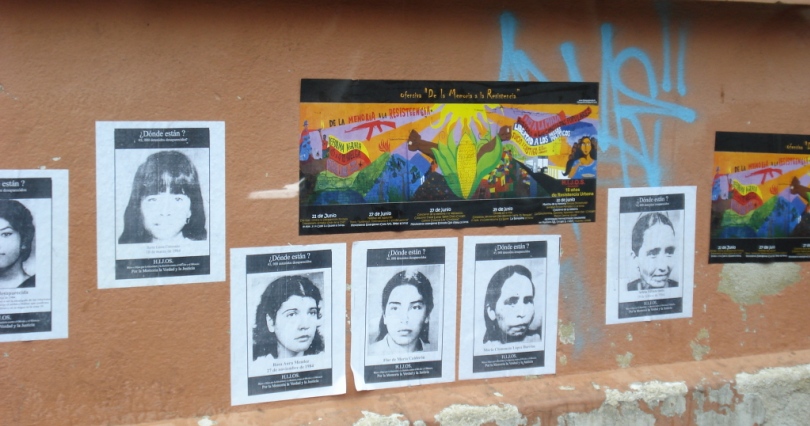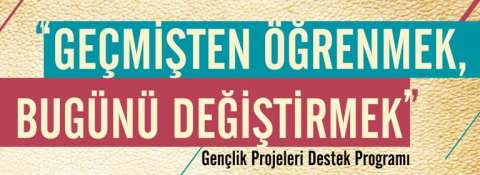
Maritza Urrutia: Women played a very significant role in Guatemala’s struggle for truth and justice
Interview by Emrah Gürsel
In Guatemala in 1954, fearing the spread of communism under the liberal democratic government of Jacobo Árbenz, the United States supported a coup that established a military junta regime. The war, waged between state forces and the guerrilla movement standing up against the authoritarian regime, came to an end with the signing of a UN-sanctioned peace treaty in 1996. Like many other countries in South America, enforced disappearance was a systematic practice applied by the military regime with the aim of weakening movements, organizations and people considered to be supporters of the guerrilla resistance. Along with the peace agreement, the United Nations established a Commission for Historical Clarification (Comisión para el Esclarecimiento Histórico, or CEH). The commission found that the oppressive regime was backed not only by the armed forces, but also by other state institutions, especially judicial bodies. According to the report, out of the four regions that were most affected by the violence, state agents committed acts of violence against the Mayan people. While the total number of people killed over the thirty-six year conflict was over 200,000, 83% of the victims were Mayan and 17% were Ladino. The report attributed 93% of the violations to the state and its paramilitary organizations.
One morning in July of 1992, Maritza Urrutia brought her son to school like she did every day. As she returned home from the school, Urrutia was kidnapped by state officials, held in an illegal detainment center, and was tortured for eight days. As a result of the threats and pressure toward her and her family, Urrutia was forced to accept that she was a member of the guerrilla organization EGP and to incriminate herself by repeating those words on a video recording. Unable to bear the threats after she was released, she fled to the United States.
Urrutia opened a case at the Inter-American Court of Human Rights (IAHCR) that ended in 2003, finding the Guatemalan state guilty. Urrutia and her family were paid a significant amount as reparation. In the decision, the court’s emphasis on the dimension of psychological torture outside of physical torture represents a significant legal landmark. Of the forty thousand people kidnapped by state forces, very few were able to stay alive. Urritia currently lives in Holland and continues her battle as a human rights advocate. We spoke with her about what she has experienced and about the struggle to confront the past in her country. Can you explain a little about what the atmosphere in Guatemala was like in 1992?
Because of their opposition to the policies applied by military governments and their puppet civil governments, it is believed that approximately forty thousand people from various communities, belief systems, and social sectors were disappeared.
The war in Guatemala started in 1960 and ended with the signing of the peace agreements in 1996. Peace meetings actually started in the 80s. Even though the war continued through all of 1992, it was a time marked by meetings between the guerrilla groups and the state. In order to obtain information about the guerrillas, tactics of kidnapping and disappearance continued via specific methods of execution, the armed conflict between both sides, and state instruments. There was a climate of fear and oppression in society. Had it ever crossed your mind that there was a possibility of your kidnapping? During the years when I had a place in the guerrilla movement I was always afraid for my life because of political reasons; I knew that state forces were following the activities to which I devoted myself. These forces used kidnapping, disappearance, and murders for years against all of the opposition, not just the guerrillas but generally against collective organizations, as a method of waging war. Did anyone else in your community disappear? Over the course of the conflict I lost my classmates, my relatives, the friends of my relatives, and my friends from the struggle in Guatemala. A large number of families in Guatemala experienced the pain of losing members and friends. Because of their opposition to the policies applied by military governments and their puppet civil governments, it is believed that approximately forty thousand people from various communities, belief systems, and social sectors were disappeared. How were you and your family affected by the kidnapping? The primary effect of my kidnapping was the fear that my life was going to end. This was a common experience in our country and we all knew that someone who disappeared was not going to return alive. If the relatives were lucky, a body bearing the traces of torture would turn up somewhere in the country, but most of the time it was never found. For the length of the eight days I was kidnapped, I was scared that this was also going to be my fate. After my release, another important effect besides the fear was the separation of my family. I was forced to defect with my four-year-old son. However, my mother, father, and sister remained in Guatemala. Despite the conditions set by those who kidnapped me (that I must not leave the country, that I must remain and cooperate with them), my relatives had a fear that something would happen to them, that they would be punished because I had left the country. Thirdly, the pain caused by being unable to ever return to my homeland, the pain of being unable to look after my family and friends… After you were rescued, what did you do and how did you continue your fight?
As a victim I’m not looking for revenge; I need to know the truth about the causes and responsible parties concerning my disappearance in order for me to be able to fully heal and to have a share in the future of my country.
Two months after gaining my freedom and leaving the country, I first explained my experiences at the United States Department of State as well as at the Inter-American Court for Justice. Afterwards, I traveled through several European countries explaining what happened to me. In the years that followed, I opened a case at the Inter-American Court, to which the Guatemalan state is a signatory. Over the course of this whole process, I have been involved in various activities directed toward winning back collective memory and honoring the search for justice and truth as well as the victims of the conflict and those affected by it in some way.
As a victim what were your demands? To what degree were these demands met by the Inter-American Court’s finding the state guilty?
As a victim I want for justice to occur, for those who acted outside of the law to pay for their crimes, and for the end of impunity, which is the point in question for all of these cases of disappearance and execution. If the crimes of the past are not adjudicated then the same things will certainly continue to happen today. The impunity that our people are experiencing today is directly related to the crimes committed in the past. As a victim I’m not looking for revenge; I need to know the truth about the causes and responsible parties concerning my disappearance in order for me to be able to fully heal and to have a share in the future of my country.
The decision of the Inter-American Court only dealt with economic reparations. Although the decision is only officially binding, the results themselves were significant for all of my family members and for me personally. In a certain way, it has the same meaning as recognizing the truth and accepting what occurred.

During what period and, in your opinion, for what reasons did the Guatemalan state use the policy of disappearance? What were the social and political consequences of it?
Since the very beginning of the armed conflict in Guatemala, the state has practiced enforced disappearance and similar planned executions. This was not only against members of the guerrilla, but also against any forces that opposed their political, social, and economic policies. Our people have been subject to psychological terror since the start of the conflict in the 60s and we have become a psychologically broken society full of fear as a result of the continuous and systematic violence that we still continue to experience today. Disappearance was used as a method to gather information about the guerrillas or about other democratic opposition groups. Disappearance is an open wound, a disintegrated family, a perpetual pain. We see segments of society that cannot forget what they experienced, peoples and communities separated from one another in rural regions and in cities. These are people who cannot forget that someone they loved left the house and never returned.
It is clear that the state used disappearance in order to scare and terrorize society and to criminalize struggles and demonstrations to which every individual has a right. By using this policy systematically, the state has trampled over the laws, taken refuge in impunity, and given permission to any segment of society to do the same thing.
Concerning the policy of disappearance, in what state are impunity, memory, and processes of restoration at the moment?
In the struggle for truth and justice, women have played a very significant primary role. They were the only ones from their families who stayed alive. As a result of the discrimination and inequality they were exposed to for their female and local identities, they were left powerless. Despite all of this, they were forced to fight with all their strength in order to find their relatives.
For the past twenty years, victims and victims’ families have continued to look for the people they love and have sought truth, justice, and compensation. There are groups in rural regions and cities who are working to find the remainder of the disappeared in order to honor those disappeared and to initiate the legal process with the information about those who have been found. There are people who have been able to determine the various locations of graves and succeeded in pursuing justice with the proof they found in these graves. These cases are in a complicated and politicized state. However, the victims’ groups are very strong and will not back down until they win. In the struggle for truth and justice, women have played a very significant primary role. They were the only ones from their families who stayed alive. As a result of the discrimination and inequality they were exposed to for their female and local identities, they were left powerless. Despite all of this, they were forced to fight with all their strength in order to find their relatives.
There are many social settings and memorials that exist for memory of the conflict; certain days have been designated for remembering the victims. There is a great struggle against forgetting what happened. It is a pronounced struggle to honor the victims and the survivors.
What are the important milestones for the struggle for truth and justice in Guatemala?
The signing of peace agreements is important, as they remain an important moment in the mind. A moment in which we can imagine a different world, in which we can look with hope at the future. The other important development was the publication of reports by the Catholic Church and the international community about what happened during the time of the armed conflict. Through these reports, we have been able for the first time to hear what actually happened in Guatemala, what each side in the armed struggle actually did. State forces were found responsible for more than 93% of the crimes committed. These are developments that I personally find significant in my country, but they may not be quite as significant for others. These forces, which see Guatemalan civil society as a threat to their own interests and which remain in political and economic power, continue to become more sharply factionalized and polarized.
Why is truth as important as justice?
Truth is a condition without which it is not possible to heal a society or its individuals. The absence of truth is like walking without seeing. We need truth in order to end the pain of survivors; we need truth in order to be able to bury our dead. Without truth, regardless of how violent or painful it is, we cannot confront the future as a people. Truth and justice exist together; we cannot possess only one of them.
We must additionally find a path that passes beyond the mere symbolic value of justice and constructs the conditions necessary for it to be transformative.
*Photos courtesy of Zachary Towne-Smith and Guillermo Pineda.



